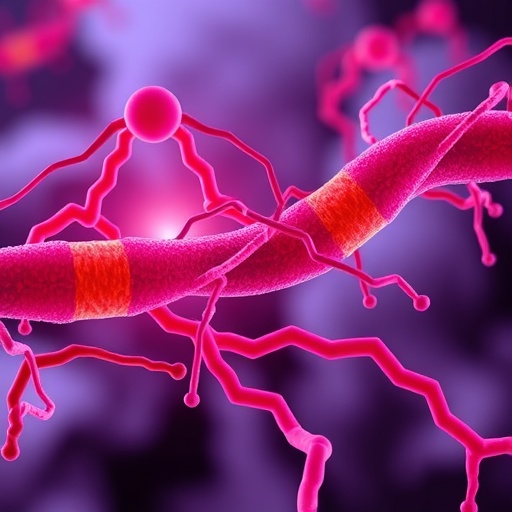Cathepsin K, a cysteine protease primarily known for its role in bone metabolism, has emerged as a significant player in the complex interplay between glucose metabolism and cardiovascular health, particularly in individuals suffering from Type 2 Diabetes Mellitus (T2DM). Recent findings from a study led by Averta et al. shed light on an intriguing and novel association between elevated levels of cathepsin K, insulin resistance, glucose intolerance, and subclinical atherosclerosis. This research could pave the way for innovative therapeutic strategies targeting cathepsin K in preventing and managing diabetic complications.
Type 2 Diabetes Mellitus is a metabolic disorder characterized by insulin resistance and hyperglycemia. As the prevalence of T2DM continues to rise globally, elucidating the underlying biological mechanisms is critical for developing effective preventative measures. One area of exploration involves understanding how various biomarkers correlate with insulin sensitivity and cardiovascular health. Among these biomarkers, cathepsin K has captured the research community’s attention due to its multifaceted roles beyond osteoclast differentiation and bone resorption.
The study conducted by Averta and colleagues points to cathepsin K as a possible link between glucose metabolism and vascular health. The researchers observed that elevated cathepsin K levels correlated with indices of glucose intolerance and diagnostic markers of insulin resistance. Such findings compel a reevaluation of the conventional understanding of cathepsin K, suggesting that its functionalities extend beyond the skeleton, influencing metabolic pathways integral to glucose homeostasis.
In their analysis, the researchers employed a cohort comprising individuals with T2DM to analyze serum levels of cathepsin K alongside various metabolic parameters. Their rigorous statistical evaluation confirmed that high concentrations of this protease were significantly associated with impaired insulin action, highlighting a pathological relationship that deserves further investigation. The cross-sectional design of the study propelled interesting questions concerning the potential causative dynamics between cathepsin K activity and metabolic dysregulation in diabetic patients.
Despite emerging evidence positing cathepsin K as a critical factor in metabolic dysregulation, the mechanisms underlying this association are far from fully understood. One hypothesis suggests that cathepsin K may influence the action of insulin through various pathways, including modulation of inflammatory responses and extracellular matrix remodeling. In particular, the protease’s role in the recruitment and activation of immune cells could contribute to insulin resistance, a fundamental characteristic of T2DM.
Furthermore, the interplay between cathepsin K and vascular health cannot be overlooked, especially given its newfound link to subclinical atherosclerosis. This condition, often undiagnosed until it progresses significantly, poses a substantial risk for cardiovascular events in diabetic patients. By unveiling the associations between cathepsin K levels and early indicators of atherosclerosis, the study provides valuable insights into how this enzyme may serve as a biomarker for cardiovascular risk stratification in T2DM.
Averta et al. emphasize the importance of longitudinal studies to ascertain whether elevated cathepsin K levels indeed precede the development of insulin resistance and subclinical atherosclerosis. This could also lead to the exploration of intervention strategies aimed at mitigating cathepsin K activity, thereby potentially improving insulin sensitivity and vascular health. Given the enzyme’s involvement in various cellular processes, targeted therapies may hold promise in addressing not only glucose intolerance but also its cardiovascular implications.
Moreover, considering the wider implications of cathepsin K in metabolic syndrome, it is essential to devise research frameworks that include diverse populations. Since T2DM manifests differently across ethnicities and demographics, appreciating the multifactorial influences on cathepsin K levels may reveal population-specific therapeutic avenues. Such an approach could enhance the translation of research findings into clinical practice, thereby fostering more equitable healthcare outcomes.
As the scientific community grapples with a rapidly evolving understanding of diabetes and its complications, research like that conducted by Averta et al. highlights the need for integrative approaches in treatment strategies. The multifactorial nature of T2DM necessitates that therapies transcend conventional boundaries and address the systemic linkages between metabolism, inflammation, and vascular health.
In light of these findings, future investigations should also focus on the potential reversibility of cathepsin K’s negative effects via lifestyle interventions. Given the well-documented impact of diet and physical activity on diabetes management, examining how these lifestyle factors modulate cathepsin K levels could yield actionable insights for patient care.
Another interesting avenue for exploration lies within the interaction between cathepsin K and other metabolic hormones like adiponectin and leptin, which play pivotal roles in energy homeostasis and inflammation. How cathepsin K influences the secretion or action of these hormones, in turn affecting insulin sensitivity, warrants comprehensive study.
As we anticipate further insights from the ongoing investigation into cathepsin K, its emerging role as a biomarker and potential therapeutic target exemplifies the importance of hypothesizing beyond established paradigms. By doing so, researchers can drive innovation in diabetes management, ultimately improving the quality of life for millions living with T2DM worldwide.
In summary, the research conducted by Averta et al. has opened up a new frontier in our understanding of cathepsin K’s role in metabolic health. With its association with insulin resistance and subclinical atherosclerosis, cathepsin K emerges not only as a biomarker of interest but potentially a therapeutic target in the fight against diabetes and its associated complications. This pathway means that future research could play a crucial role in defining novel and effective strategies for the prevention and management of Type 2 Diabetes Mellitus.
Integrating a multidisciplinary approach, leveraging both clinical and translational research, will be essential in fully elucidating the mechanics behind cathepsin K and its intricate relationship with insulin resistance and cardiovascular health. The medical community and research institutions must prioritize these explorations to impact public health frameworks positively, particularly for at-risk populations confronted with the impending challenges posed by diabetes and its complications.
As we stand on the precipice of a deeper understanding of how enzymes like cathepsin K affect our health, the hope is that continuous research will arm health professionals with the tools necessary to combat diabetes more effectively. With an eye toward the future, the findings of this study are paving the way for a radical rethinking of how we define and address the risk factors associated with Type 2 Diabetes Mellitus.
Subject of Research:
Type 2 Diabetes Mellitus (T2DM) and its association with cathepsin K activity.
Article Title:
Cathepsin K: a novel association with glucose intolerance, insulin resistance, and subclinical atherosclerosis in T2DM.
Article References:
Averta, C., Rubino, M., Mancuso, E. et al. Cathepsin K: a novel association with glucose intolerance, insulin resistance, and subclinical atherosclerosis in T2DM. J Transl Med 23, 1046 (2025). https://doi.org/10.1186/s12967-025-07079-w
Image Credits:
AI Generated
DOI:
https://doi.org/10.1186/s12967-025-07079-w
Keywords:
Cathepsin K, Type 2 Diabetes Mellitus, Insulin Resistance, Glucose Intolerance, Subclinical Atherosclerosis, Metabolic Health, Biomarkers.
Tags: biomarkers in diabetes managementCathepsin K and glucose metabolismcysteine protease and metabolic disordersdiabetes complications and protease activityglucose intolerance and vascular healthinsulin resistance and atherosclerosisnovel therapeutic strategies for T2DMrelationship between cathepsin K and insulin sensitivityresearch on cathepsin K in cardiovascular diseasesubclinical atherosclerosis and cathepsin KType 2 Diabetes Mellitus and cardiovascular healthunderstanding biomarkers in Type 2





